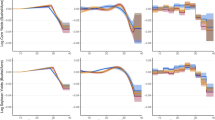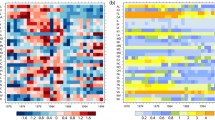Abstract
Annual production shocks at the farm-level are driven by year-to-year weather variability. While identifying drivers of these shocks is important and well-researched, little attention has been paid to the extent to which these shocks aggregate up to the regional or national level. Here, we provide a method for simultaneously modeling the mean, variance, and spatial correlation of crop yields in the presence of evolving technology. Our approach allows one to condition spatial correlations on variables of interest—such as weather—in a straightforward manner. An application to state-level Iowa and Illinois corn yields provides evidence that spatial correlations roughly double in both good and bad weather years relative to normal years. Furthermore, we consider several functional forms for conditioning spatial correlations on weather and find that less flexible relationships generate misleading results as they vastly underestimate the degree of correlation in bad weather years. These findings have important implications for the climate change, food price volatility, crop insurance, and yield modeling literatures.


Similar content being viewed by others
Notes
In the absence of ethanol-based demand for corn, Adjemian and Smith (2012) estimate this flexibility to be −1.51. The authors also provide a nice overview of the price flexibility literature, which started when Moore (1919) introduced the term flexibility of prices (Houck 1966). Examples of published price flexibilities include Gray et al. (1995) and Chua and Tomek (2010).
The nine regions correspond to the “standard regions” as defined by Karl and Koss (1984). They include the Northeast; Upper Midwest (East North Central); Ohio Valley (Central); Southeast; Northern Rockies and Plains (West North Central); South; Southwest; Northwest; and West.
The available RCEI’s are: Annual (Jan–Dec); Spring (Mar-May); Summer (Jun–Aug); Fall (Sep–Nov); Winter (Dec–Feb); Warm Season (Apr–Sep); Cold Season (Oct–Mar); and Hurricane Season (Jun–Nov).
As noted on the CEI web page, mean maximum and minimum temperature stations were selected from the U.S. Historical Climatology Network (USHCN). Daily precipitation stations were extracted from the USHCN daily database and supplemented by Summary of the Day (TD3200) and pre-1948 (TD3206) daily precipitation stations. The NCDC climate division precipitation and temperature databases are used to calculate the PDSI (Karl 1986).
The in-sample mean-squared-error for the cubic (local) model was 133.7 (141.8) for Iowa and 139.1 (144.9) for Illinois. A leave-one-out cross-validation exercise to assess out-of-sample performance produced the same pattern of results.
A one-sample KS test for normality suggests rejection of the null at standard significance levels (p-value =0.003)
References
Adjemian MK, Smith A (2012) Using usda forecasts to estimate the price flexibility of demand for agricultural commodities. Am J Agric Econ 94(4):978–995
Alston J, Andersen M, James J, Pardey P (2010) Persistence pays: US agricultural productivity growth and the benefits from public R and D spending. Springer, New York
Bellemare MF, Barrett CB, Just DR (2013) The welfare impacts of commodity price volatility: evidence from rural ethiopia. Am J Agric Econ 95(4):877–899
Berry ST, Roberts MJ, Schlenker W (2013) Corn production shocks in 2012 and beyond: Implications for harvest volatility. In: The economics of food price volatility. University of Chicago Press, pp 59–81
Chua HW, Tomek WG (2010) On the relationship of expected supply and demand to futures prices. Working Paper SP 2010-01, Cornell Department of Applied Economics and Management, Staff Paper
Claassen R, Just RE (2011) Heterogeneity and distributional form of farm-level yields. Am J Agric Econ 93(1):144–160
Conley TG (1999) Gmm estimation with cross sectional dependence. J Econ 92(1):1–45
Dell M, Jones BF, Olken BA (2014) What do we learn from the weather? The new climate-economy literature. J Econ Lit 52(3):740–98
Deschenes O, Greenstone M (2007) The economic impacts of climate change: evidence from agricultural output and random fluctuations in weather. Am Econ Rev 97(1):354–385
Evenson RE (2001) Economic impacts of agricultural research and extension. Handb Agric Econ 1:573–628
Fisher A, Hanemann W, Roberts M, Schlenker W (2012) The economic impacts of climate change: evidence from agricultural output and random fluctuations in weather: comment. Am Econ Rev 102(7):3749–3760
Goodwin BK (2001) Problems with market insurance in agriculture. Am J Agric Econ 83(3):643–649
Goodwin BK (2015) Agricultural policy analysis: the good, the bad, and the ugly. Am J Agric Econ 97(2):353–373
Goodwin BK, Hungerford A (2015) Copula-based models of systemic risk in us agriculture: implications for crop insurance and reinsurance contracts. Am J Agric Econ 97(3):879–896
Gray AW, Richardson JW, McClaskey J (1995) Farm-level impacts of revenue assurance. Rev Agric Econ 17(2):171–183
Harri A, Coble KH, Ker AP, Goodwin BJ (2011) Relaxing heteroscedasticity assumptions in area-yield crop insurance rating. Am J Agric Econ 93(3):707–717
Houck JP (1966) A look at flexibilities and elasticities. J Farm Econ 48(2):225–232
Huffman WE, Evenson RE (2006) Do formula or competitive grant funds have greater impacts on state agricultural productivity? Am J Agric Econ 88(4):783–798
Just RE, Weninger Q (1999) Are crop yields normally distributed? Am J Agric Econ 81(2):287–304
Karl TR (1986) The sensitivity of the palmer drought severity index and palmer’s z-index to their calibration coefficients including potential evapotranspiration. J Clim Appl Meteorol 25(1):77–86
Karl T, Koss WJ (1984) Regional and national monthly, seasonal, and annual temperature weighted by area, 1895–1983. National Climatic Data Center
Karl TR, Knight RW, Easterling DR, Quayle RG (1996) Indices of climate change for the united states. Bull Am Meteorol Soc 77(2):279–292
Mahul O, Stutley CJ (2010) Government support to agricultural insurance: Challenges and opportunities for developing countries. Tech. rep., prepared for the World Bank, Washington DC
Meehl GA, Zwiers F, Evans J, Knutson T, Mearns L, Whetton P (2000) Trends in extreme weather and climate events: issues related to modeling extremes in projections of future climate change. Bull Am Meteorol Soc 81(3):427–436
Moore HL (1919) Empirical laws of demand and supply and the flexibility of prices. Polit Sci Q 34(4):546–567
Roberts MJ, Schlenker W (2013) Identifying supply and demand elasticities of agricultural commodities: Implications for the US ethanol mandate. Am Econ Rev 103(6):2265–95
Rosenzweig C, Iglesias A, Yang X, Epstein PR, Chivian E (2001) Climate change and extreme weather events: implications for food production, plant diseases, and pests. Glob Change Hum Health 2(2):90–104
Schlenker W, Roberts M (2006) Nonlinear effects of weather on corn yields. Appl Econ Perspect Policy 28(3):391–398
Schlenker W, Roberts M (2009) Nonlinear temperature effects indicate severe damages to US crop yields under climate change. Proc Natl Acad Sci 106 (37):15,594–15,598
Seneviratne SI, Donat MG, Mueller B, Alexander LV (2014) No pause in the increase of hot temperature extremes. Nat Clim Chang 4(3):161–163
Smith VH, Glauber JW (2012) Agricultural insurance in developed countries: Where have we been and where are we going? Appl Econ Perspect Policy s029
Tack J, Harri A, Coble K (2012) More than mean effects: modeling the effect of climate on the higher order moments of crop yields. Am J Agric Econ 94(5):1037–1054
Trenberth KE, Dai A, van der Schrier G, Jones PD, Barichivich J, Briffa KR, Sheffield J (2014) Global warming and changes in drought. Nat Clim Chang 4(1):17–22
Urban D, Roberts MJ, Schlenker W, Lobell DB (2012) Projected temperature changes indicate significant increase in interannual variability of us maize yields. Clim Chang 112(2):525–533
Villavicencio X, McCarl B, Wu X, Huffman W (2013) Climate change influences on agricultural research productivity. Clim Chang 119(3–4):815–824
Wright P (1928) The tariff on animal and vegetable oils. Investigations in international commercial policies. The Macmillan company. http://books.google.com/books?id=zJBBAAAAIAAJ
Yu T, Babcock BA (2010) Are us corn and soybeans becoming more drought tolerant? Am J Agric Econ 92(5):1310–1323
Author information
Authors and Affiliations
Corresponding author
Electronic supplementary material
Below is the link to the electronic supplementary material.
Rights and permissions
About this article
Cite this article
Tack, J.B., Holt, M.T. The influence of weather extremes on the spatial correlation of corn yields. Climatic Change 134, 299–309 (2016). https://doi.org/10.1007/s10584-015-1538-4
Received:
Accepted:
Published:
Issue Date:
DOI: https://doi.org/10.1007/s10584-015-1538-4




